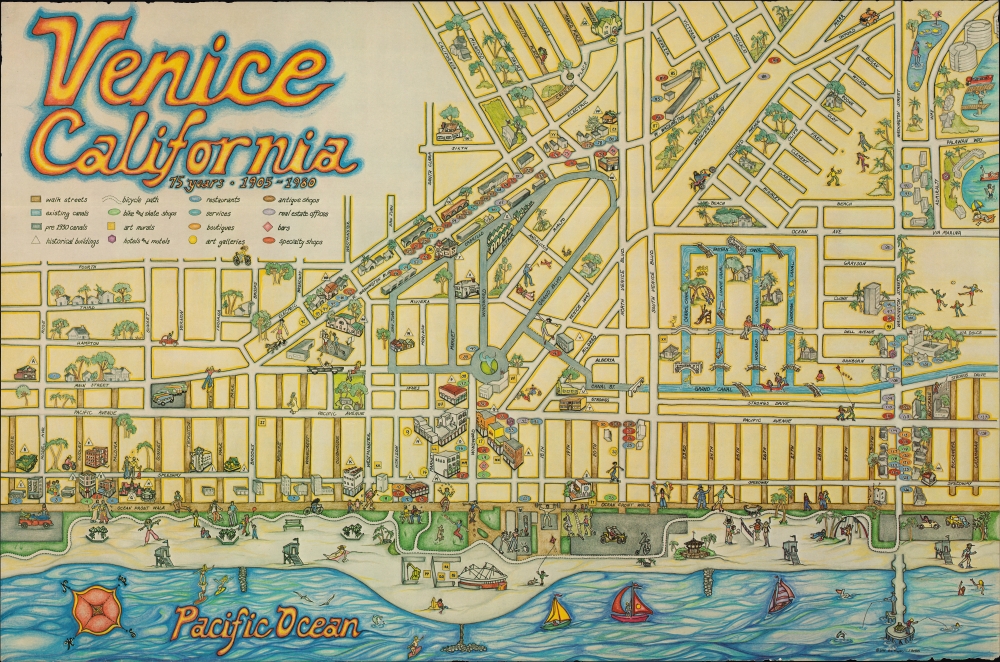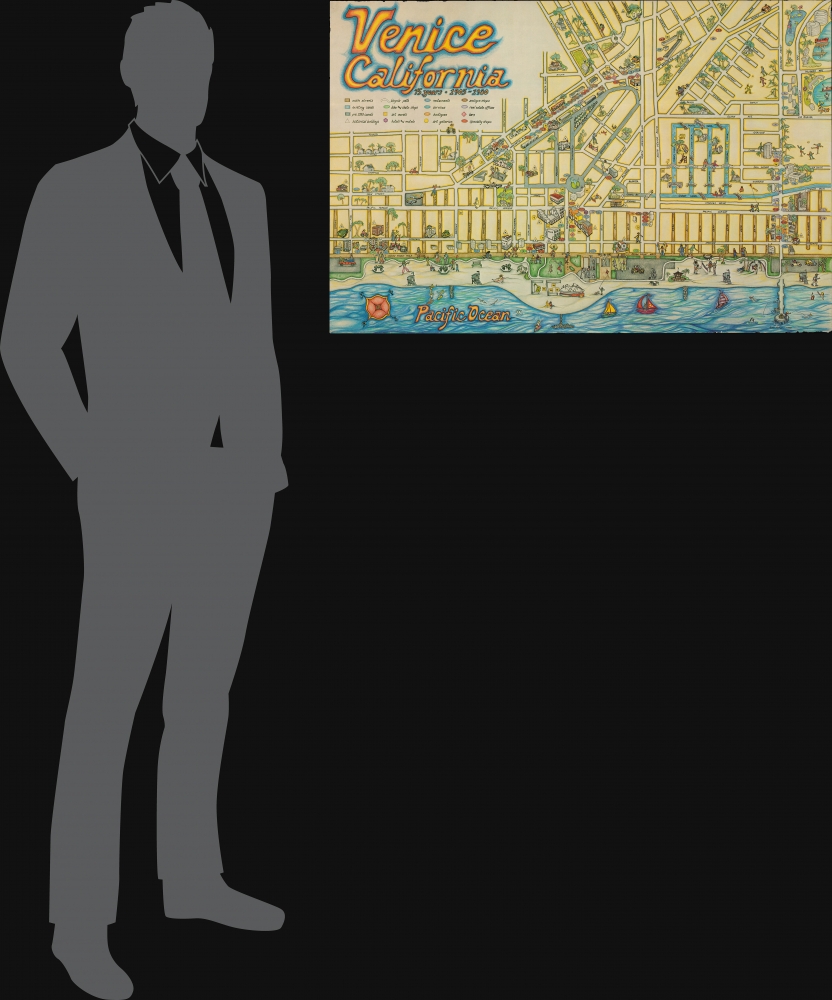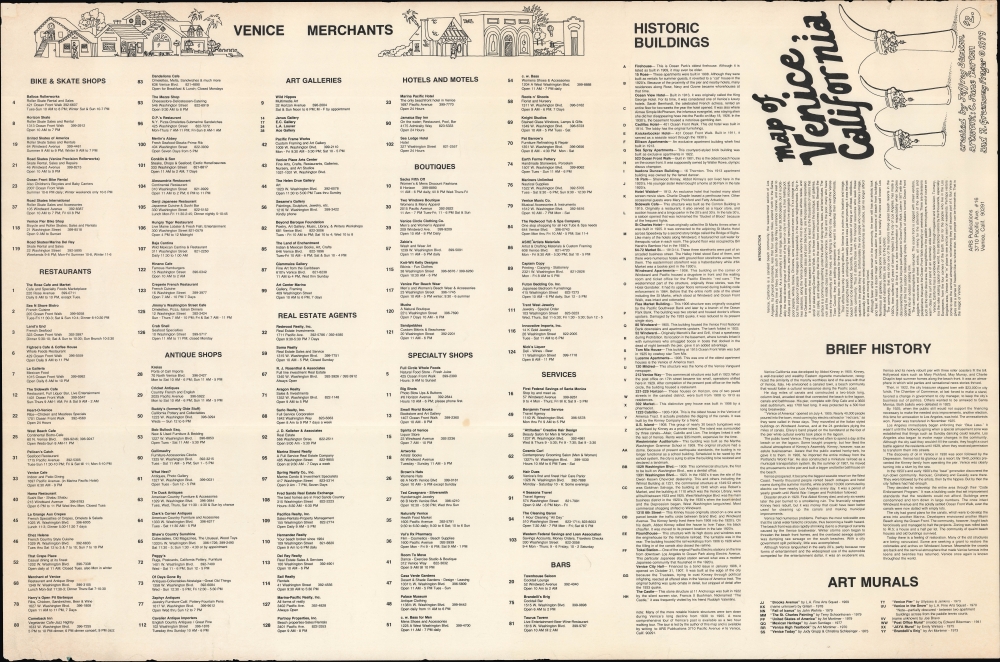This item has been sold, but you can get on the Waitlist to be notified if another example becomes available.
1979 Stanton Pictorial View of Venice, Los Angeles, California
VeniceCA-stanton-1979
Title
1979 (dated) 24 x 36.25 in (60.96 x 92.075 cm)
Description
A Closer Look
A labor of love by a lover of his community, this view is oriented towards the northeast, taking in the main commercial and residential center of Venice, California, from Ozone Avenue near the border with Santa Monica to Catamaran Street near Marina del Rey, and as far east as the Crescent Place Triangle. West Washington Blvd., one of the neighborhood's main thoroughfares, has been renamed Abbot Kinney Blvd. since the early 1990s. Prominent and recognizable buildings, along with the area's famous canals and a variety of human figures (biking, roller skating, playing music, exercising, and more), are illustrated throughout. Historic buildings are noted (triangles), art murals (squares), hotels and motels (hexagons), and businesses (ovals and circles), all of which are listed on the verso. The verso further also includes an introduction and brief history of the neighborhood, both delivered in Stanton's unvarnished and cantankerous tone.From Seaside Resort to Silicon Beach
Founded in 1905 as the brainchild of Abbot Kinney, a tobacco merchant, world traveler, and conservationist who invested heavily in Los Angeles real estate, Venice, California was designed as a seaside resort meant to emulate its Italian namesake. Kinney had canals dug to drain the existing marshes and constructed a pier constructed with Venetian-style architecture. Soon afterward, more attractions were added, including an aquarium, miniature railway, bathhouse, racing derby, gondolas, and air stunt shows. Like Santa Monica to its immediate north, Venice proved a hit with the growing population of Los Angeles and surrounding communities, who could access the beaches easily via the Pacific Electric Railway.However, bad luck struck in threes: in 1920, Prohibition began, hurting the town's businesses and tax revenue, the pier burned down, and Kinney died. The pier was rebuilt, with roller coasters to boot, but the lack of infrastructure and funds caused Venice to be consolidated with Los Angeles in 1926. Afterward, the combination of the Great Depression and notorious, decades-long neglect by Los Angeles caused Venice to be seen as a dilapidated shell of a bygone era. Many of the canals were filled in and paved (as seen on the recto), and Venice came to be known as 'the slum by the sea.'
At the same time, Venice's perceived lack of desirability made it an affordable option for bohemians, artists, working class residents, immigrants, and refugees, giving the neighborhood the distinctive multicultural character it maintains. It also became known as a mecca for skateboarding, street art, and musicians. However, as Stanton recounts with vitriol, Venice's popularity and various redevelopment plans were causing it to become unaffordable to its established residents at the time of this view's publication. This situation has continued to the present day, with rents and home prices skyrocketing, especially in recent years with the 'Silicon Beach' phenomenon attracting technology companies and high-paid workers to Venice and neighboring communities.
Publication History and Census
This 1979 view was edited by Jeffrey Stanton, illustrated by C. June Barton and R. Freenway Frager, and published by ARS Publications, a local outfit that mostly worked with Stanton. In 1985, Stanton prepared a 'Venice California Map,' a second edition of the present work, but with many additions that meant to be humorous but proved controversial and provoked a negative reaction from the community. As a July 1985 article in the Los Angeles Times recounts, the Venice Chamber of Commerce had ordered 150 copies of the map and sold nearly a third of them before 'banning' it for projecting harmful stereotypes about the neighborhood, including prostitution, homelessness, and crime. In any event, we are unaware of either edition of the map being held by any institutions, while it only occasionally appears on the market.Cartographer
Jeffrey Stanton (c. 1945 - present) is an engineer, artist, and local historian based in Venice, Los Angeles. Born in Pittsburgh, Pennsylvania, he attended the Rensselaer Polytechnic Institute and studied mechanical engineering, earning a master's degree, before moving to Los Angeles to work for the aerospace and defense company McDonnell Douglas. Soon afterwards, he developed an interest in the history of L.A.'s beachfront communities, became an amateur photographer, and moved to Venice. Stanton is known for having an exceptionally large collection of antique postcards, a portion of which he sold from a stall on the Venice Boardwalk for many years. He also collected materials relevant to Venice's history, including early photographs, and authored books titled Summer is forever : the Southern California beach towns (1975) and Venice of America: Coney Island of the Pacific (published in several editions). More by this mapmaker...






